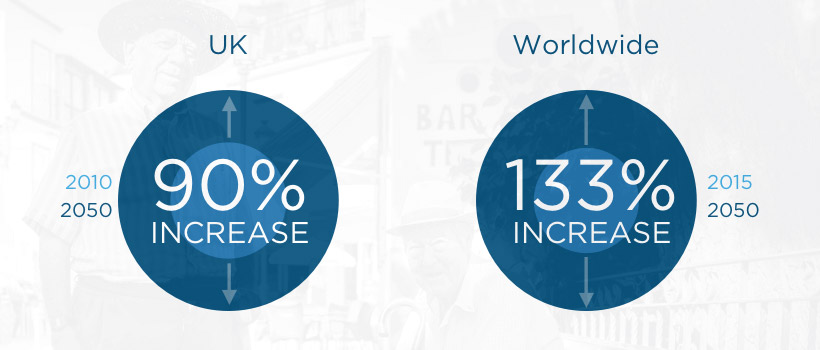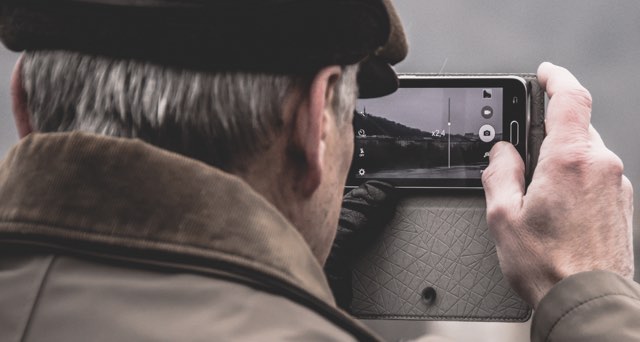Age-Inclusive Design is incredibly powerful! Beyond accessibility cul-de-sacs, we should aim to create designs that make our digital products open to more people, easy to use and are ultimately timeless. Here’s how.
I’ve been musing over the issue of age-neutral design ever since reading a blog featured in the Creative Review last year. It got me to thinking – why have I, and other designers I know, not really considered the 65+ age group in the past?
“But old people don’t use technology!”
This statement says it all. Personally, I believe that this way of thinking has been deep-seated in most digital design for a long time. Being from a generation where my grandparents are from an analogue time of steam trains, the British Empire and cross-stitching, they had zero interest in our super-cool tech. Give them a greenhouse and a cock-a-too and they were happy.

On the other hand, we were starting up technology firms and exploring the boundaries of what digital design could do. Doing that, we were quite happy to leave our grandparents behind. It was much more gratifying to us to create and design for ourselves and our peers.
Think Selfishly – For Everyone’s Sake!
I don’t know whether you’ve noticed... you get older as time goes on. Those numbers on your birthday get bigger as the years go on. That’s right young buck, YOU ARE GETTING OLD! Whatever you’re designing now, you’re going to have to deal with yourself when you hit that 65+ bracket. Imagine that?
Let’s get going with some predictions on population. After all, the older generations are growing, and it always seems to be mentioned in the news. The UK government’s predicted the 65+ age group nearly doubling from 10million in 2010 to 19million in 2050. Similarly, in 2015 the UN reported 901 million over 60s. By 2050, this is due to rise to 2.1 billion.

Enormous increases I’m sure you agree and we will be involved in that number. For example, I’ll be in my 70s when 2050 hits! Shocking, but true.
But what about the older generation using technology? Well, the ONS reported that 1/3 of over 75s went on the world wide web over a three month period. Old people don’t use technology? Think again.
To summarise – we have to start designing for our future selves because we will be in that massive demographic. If we consider the needs of older people, we’re going to be doing them, and us, an enormous favour. Here’s to selfishness! Haha.
Age-Inclusive Design Heuristic: ABCD
Let's kick-start this selfish/inclusive, almost two-faced way of thinking. I’ve created the ABCD age-inclusive design heuristic. Hopefully, this will help you and your projects be more ageing friendly!
Please bear in mind that, yes, there is crossover with accessibility guidelines, but they are just part of what I’m doing. This is not an accessibility guideline.
Also, before I start, this is a living and breathing idea, and I want it to evolve over time. If you have any opinions on the subject, please get involved by tagging @cyberduck_uk on Twitter!
A – ATTITUDE
Have you thought of attitudes towards digital products?
All generations, hell – all people, have different attitudes to tech. Millennials trust user-generated content and share a lot, seeing as baby-boomers I’ve spoken to about sharing can be very hesitant and distrustful. Differing views on trust and privacy across generations can be an issue and should never be forgotten in UX design.
Saying that, baby-boomers are very happy with using the tech and they will expect it to serve them as much as younger generations do. However, their attitudinal needs will be different to other generations, such as
- Personal independence
- Autonomy and control
- Physical aesthetics
- Health as a journey
- Productivity
- Social connections
These are what they want now, but ask yourself – can you see the above points being important to you too? Go back to the selfish thing and ask yourself what you’d want as you get older.

B – BODY
Have you considered the constraints of the body?
So this is the most obvious one I suppose. The body changes as it ages and that means we have to consider how we mitigate the challenges the best we can!
So, and I know you’ve all been waiting for this, it’s time to follow accessibility guidelines. In my opinion, accessibility can sometimes be too attached to disability – which has the possibility of being seen as someone else’s problem. Thinking age-inclusive empathically places designers in the shoes of our future selves, and the problems we will all face. This, in turn, will make us think accessibility-first – which is absolutely key!
I’m not going to take too much time on this – there are many many fantastic accessibility blogs you can read. But, outside of that, here are some things to think about…
Vision
In a world of screens, it’s time to question whether you need a screen-based user interface (UI). Can the UX solution be something that doesn’t need a graphical interface, with all it’s visually trickery? Don’t feel like you always HAVE to use a screen-based design – follow Golden Krishna’s mantra that ‘The Best Interface is No Interface’ and think outside the box.
On the other hand, if UI is the way forward, always consider the standard accessibility considerations of obvious visual hierarchy, clear type, colour contrast, sizing and considerate animation.
Just remember, a visual interface isn’t your only option out there.
Muscles, joints and bones etc.
Products must be designed with consideration of the muscles that people actually use to hold, tap and do whatever they need to do.
Think about the way users will hold your product – are they easy for people to use with one hand? Can they use a keyboard efficiently? Is voice recognition going to work better?
Then there’s skin to think about - ageing effects that too… Will this change the way people use touch screens?
These are a few examples I can think of that are worth a designer’s consideration.

Sound
Now that VR, AR and platforms like Amazon’s Alexa (Echo) have hit the mainstream, the way we use sound may become much more important.
Websites and apps have generally eschewed over the years. So it’s not surprising that this hasn’t been the top of the considerations. Unless, of course, you’re in the business of music, podcasts or video.
Talking of video, it’s great that subtitles are a common thing online now. But it’s worth remembering that hard of hearing is not deafness. Differences in perception of frequencies should be considered and tested for. Should we start asking sound designers and music producers for guidance?
Let’s face it, us digital designers will be adding sound considerations to our workflows in the near future. I say let’s start planning for it now. And Cyber-Duck is already leading the way. Years ago, we launched the UX Companion app. 48,000 digital professionals love how the iPhone and Android app helps them understand tricky user experience theories and techniques. Determined to try out new tech and reach new platforms... we've developed a version for Amazon Echo. Just Ask Alexa if you're stuck with UX!
C – COGNITION & MOTOR SKILLS
Have you thought about how users' brains age?
As UX designers, we are in the business of making things as easy as possible for users’ brains to understand. The threat of memory loss and effects of dementia can have wide-ranging consequences, such as reading difficulties, attention retention issues and sequence perception problems. Combatting these issues could make our designs better for everyone, not just dementia sufferers.

Looking at solutions, I feel that minimising cognitive load is a great place to start. Then we should consider the physical hardware we’re designing for to combat any motor skills issues. Are the usual suspects of mice, keyboards and trackpads right? As mentioned before, is the first device that comes to mind the right device?
There’s research on how elderly users find touch screens easier so I feel that this information should be reflected in our persona creation. Ensure that your personas include device usage information – it won't solve all issues by any means but is a good start.
D – DIVERSITY
Where are the old people at? Are they included in your process?
We’re not talking about including a badass dance-troupe in your client presentation. Although that would be fun. Instead, we’re talking about involving the 60+ bracket in our design thinking – from research to ideation, design to testing. We’ve left them out for too long – let’s get them involved.

There are challenges with involving them. Orientation with technologies (like remote testing platforms) can be a real effort. But, in the end, it’s totally worth it because their wealth of experience gives them a perspective that your nearest 25-year-old developer couldn’t even imagine.
Plus, in that experience, they have the memory of looking after their older relatives. The needs, frustrations, and feelings that they had will give them a natural empathy to the plight of the even-older generation that could help colour your project in ways that you couldn’t imagine.
So, let’s get that 60-85 year old demographic involved – let’s change our attitudes, take the hard route and make better products for it.
What Next?
Now, I know what you’re thinking. A demographic shouldn’t be a topic covered in a UX blog. It’s all about needs, frustrations, pain points – user-centred stuff. However, this group of people would be foolish to ignore.
Generally, ageing happens to everyone – as sure as death and taxes so considering it more holistically, as opposed to confining these ideas to an outpost of accessibility, will be good for us all.
Overall, age-inclusive design is intrinsically human-centred. So let’s design for our future selves! It’s not just design for ‘old’ people. It’s design that can make future digital products open to more people, easier to use and ultimately timeless. Get in touch to find out how our accredited process can put all users at the heart of real, future-friendly design.

